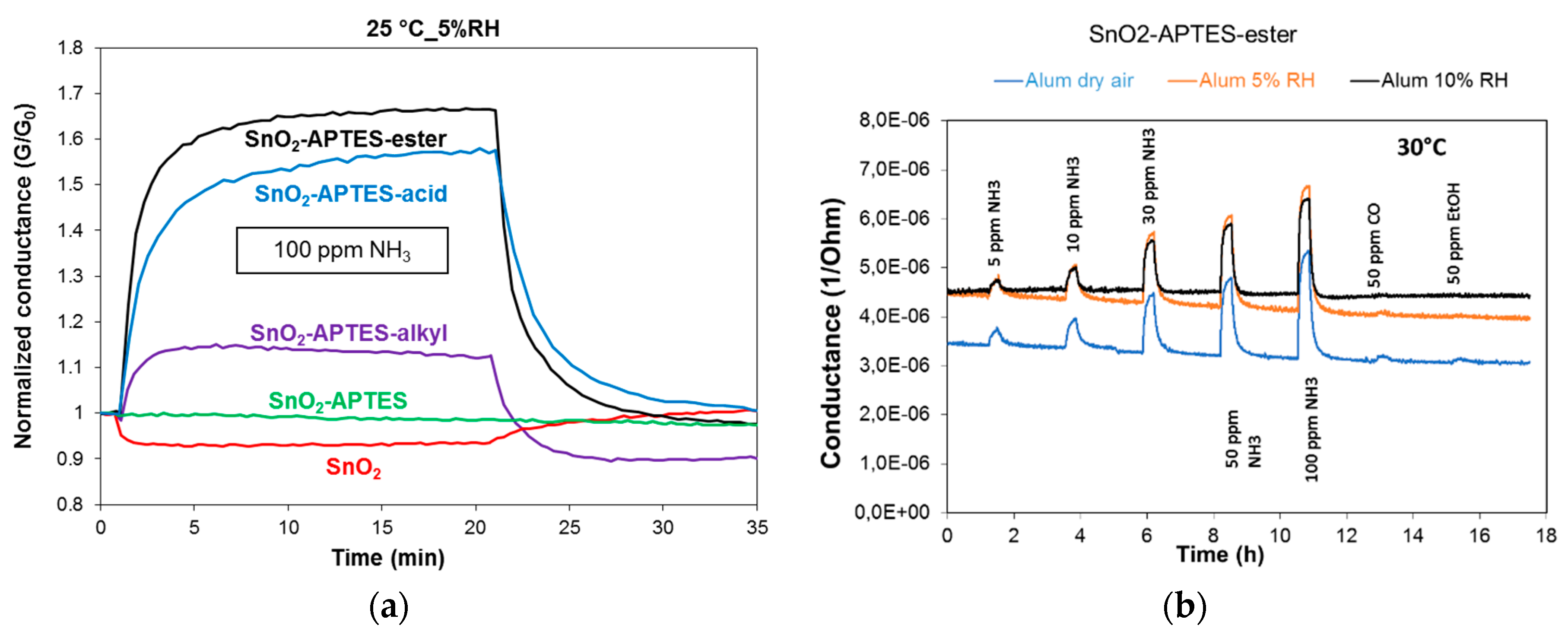Functionalized SnO2 Sensors on Flexible Substrate for Ammonia Detection at Low Temperature †
Abstract
:1. Introduction
2. Method and Results
References
- Shehada, N.; Brönstrup, G.; Funka, K.; Christiansen, S.; Leja, M.; Haick, H. Ultrasensitive Silicon Nanowire for Real-World Gas Sensing: Noninvasive Diagnosis of Cancer from Breath Volatolome. Nano Lett. 2015, 15, 1288–1295. [Google Scholar] [CrossRef] [PubMed]
- Kenry; Yeo, J.C.; Lim, C.T. Emerging flexible and wearable physical sensing platforms for healthcare and biomedical applications. Microsyst. Nanoeng. 2016, 2, 16043. [Google Scholar] [CrossRef] [PubMed]
- Hijazi, M.; Rieu, M.; Stambouli, V.; Tournier, G.; Viricelle, J.-P.; Pijolat, C. Ambient temperature selective ammonia gas sensor based on SnO2-APTES modifications. Sens. Actuators B 2018, 256, 440–447. [Google Scholar] [CrossRef]
- Kassem, O.; Saadaoui, M.; Rieu, M.; Viricelle, J.-P. A novel approach of fully inkjet printed flexible gas sensor based on tin oxide. J. Mater. Chem. C 2019, 7, 12343–12353. [Google Scholar] [CrossRef]


Publisher’s Note: MDPI stays neutral with regard to jurisdictional claims in published maps and institutional affiliations. |
© 2020 by the authors. Licensee MDPI, Basel, Switzerland. This article is an open access article distributed under the terms and conditions of the Creative Commons Attribution (CC BY) license (https://creativecommons.org/licenses/by/4.0/).
Share and Cite
Viricelle, J.-P.; Hijazi, M.; Stambouli, V.; Kassem, O.; Saadaoui, M.; Rieu, M.; Pijolat, C. Functionalized SnO2 Sensors on Flexible Substrate for Ammonia Detection at Low Temperature. Proceedings 2020, 56, 2. https://doi.org/10.3390/proceedings2020056002
Viricelle J-P, Hijazi M, Stambouli V, Kassem O, Saadaoui M, Rieu M, Pijolat C. Functionalized SnO2 Sensors on Flexible Substrate for Ammonia Detection at Low Temperature. Proceedings. 2020; 56(1):2. https://doi.org/10.3390/proceedings2020056002
Chicago/Turabian StyleViricelle, Jean-Paul, Mohamad Hijazi, Valérie Stambouli, Omar Kassem, Mohamed Saadaoui, Mathilde Rieu, and Christophe Pijolat. 2020. "Functionalized SnO2 Sensors on Flexible Substrate for Ammonia Detection at Low Temperature" Proceedings 56, no. 1: 2. https://doi.org/10.3390/proceedings2020056002



